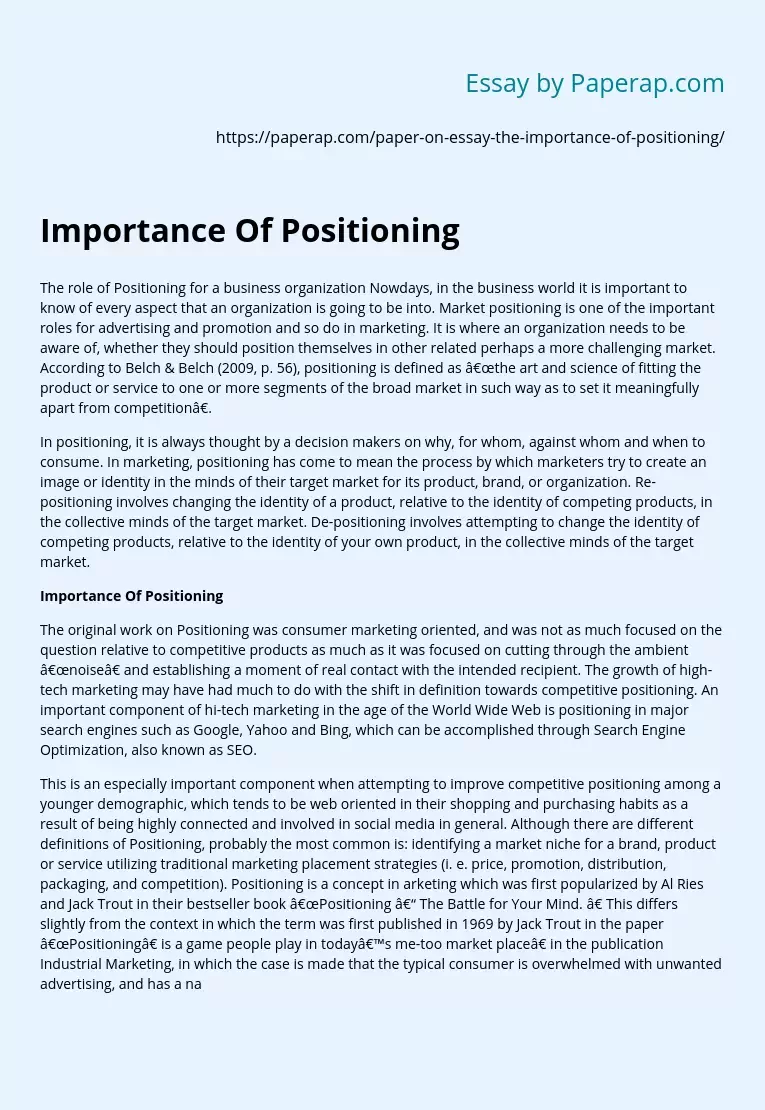Importance Of Positioning
The role of Positioning for a business organization Nowdays, in the business world it is important to know of every aspect that an organization is going to be into. Market positioning is one of the important roles for advertising and promotion and so do in marketing. It is where an organization needs to be aware of, whether they should position themselves in other related perhaps a more challenging market. According to Belch & Belch (2009, p. 56), positioning is defined as “the art and science of fitting the product or service to one or more segments of the broad market in such way as to set it meaningfully apart from competition”.
In positioning, it is always thought by a decision makers on why, for whom, against whom and when to consume. In marketing, positioning has come to mean the process by which marketers try to create an image or identity in the minds of their target market for its product, brand, or organization.
Re-positioning involves changing the identity of a product, relative to the identity of competing products, in the collective minds of the target market. De-positioning involves attempting to change the identity of competing products, relative to the identity of your own product, in the collective minds of the target market.
Importance Of Positioning
The original work on Positioning was consumer marketing oriented, and was not as much focused on the question relative to competitive products as much as it was focused on cutting through the ambient “noise” and establishing a moment of real contact with the intended recipient.
The growth of high-tech marketing may have had much to do with the shift in definition towards competitive positioning. An important component of hi-tech marketing in the age of the World Wide Web is positioning in major search engines such as Google, Yahoo and Bing, which can be accomplished through Search Engine Optimization, also known as SEO.
This is an especially important component when attempting to improve competitive positioning among a younger demographic, which tends to be web oriented in their shopping and purchasing habits as a result of being highly connected and involved in social media in general. Although there are different definitions of Positioning, probably the most common is: identifying a market niche for a brand, product or service utilizing traditional marketing placement strategies (i. e. price, promotion, distribution, packaging, and competition). Positioning is a concept in arketing which was first popularized by Al Ries and Jack Trout in their bestseller book “Positioning – The Battle for Your Mind. ” This differs slightly from the context in which the term was first published in 1969 by Jack Trout in the paper “Positioning” is a game people play in today’s me-too market place” in the publication Industrial Marketing, in which the case is made that the typical consumer is overwhelmed with unwanted advertising, and has a natural tendency to discard all information that does not immediately find a comfortable (and empty) slot in the consumers mind.
It was then expanded into their ground-breaking first book, “Positioning: The Battle for Your Mind,” in which they define Positioning as “an organized system for finding a window in the mind. It is based on the concept that communication can only take place at the right time and under the right circumstances” (p. 19 of 2001 paperback edition). What most will agree on is that Positioning is something (perception) that happens in the minds of the target market.
It is the aggregate perception the market has of a particular company, product or service in relation to their perceptions of the competitors in the same category. It will happen whether or not a company’s management is proactive, reactive or passive about the on- going process of evolving a position. But a company can positively influence the perceptions through enlightened strategic actions.
Generally, the product positioning process involves defining the market in which the product or brand will compete (who the relevant buyers are), identifying the attributes (also called dimensions) that define the product ‘space’, collecting information from a sample of customers about their perceptions of each product on the relevant attributes, determine each product’s share of mind, determine each product’s current location in the product space, determine the target market’s preferred combination of attributes (referred to as an ideal vector), examine the fit between (The position of your product and the position of the ideal vector), and lastly after all is applied it is to position the product or brand in the selected market. references: Belch/Belch,2009,
Advertising and Promotion,8th edition,MCGraw-Hill,New York Kotler, Armstrong, Swee, Chin, Oliver,2009, Principles of Marketing, Pearson Hall, Singapore Trout, J. , (1969) “”Positioning” is a game people play in today¶s me-too market place”, Industrial Marketing, Vol. 54, No. 6, (June 1969), pp. 51±55. y Ries, A. and Trout,J. (1981) Positioning, The battle for your mind, Warner Books – McGraw-Hill Inc. , New York, 1981, ISBN 0-446-34794-9 y Trout, J. and Rivkin, S. (1996) The New Positioning : The latest on the worlds #1 business strategy, McGraw Hill, New York, 1996, ISBN 0-07-065291-
Importance Of Positioning. (2019, Dec 05). Retrieved from https://paperap.com/paper-on-essay-the-importance-of-positioning/

